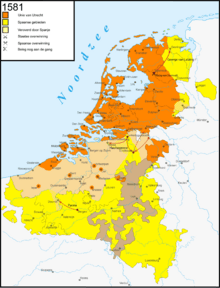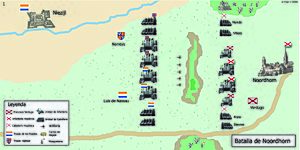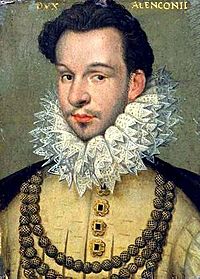Battle of Noordhorn facts for kids
Quick facts for kids Battle of Noordhorn |
|||||||
|---|---|---|---|---|---|---|---|
| Part of the Eighty Years' War | |||||||
 The States' army in Noordhorn defeated by Verdugo, 1581. Simon Frisius, 1613–1615. |
|||||||
|
|||||||
| Belligerents | |||||||
| Commanders and leaders | |||||||
| Strength | |||||||
| Exact number unknown: 3 infantry regiments, 4 cavalry companies, no artillery |
3,000 infantry, 500 cavalry, 5 cannons | ||||||
| Casualties and losses | |||||||
| Unknown | 2,000 to 3,000 killed, 5 cannons | ||||||
The Battle of Noordhorn was an important fight during the Dutch Revolt, also known as the Eighty Years' War. It happened on September 30, 1581, near the village of Noordhorn in what is now the Netherlands. This battle was between the Spanish army, led by Colonel Francisco Verdugo, and a rebel army from the Dutch States, led by an English commander named John Norreys.
In 1580, the leader of Groningen, Count Rennenberg, switched sides from the Dutch rebels to the Spanish king. This created a new problem for the Dutch Republic, forcing them to send soldiers north. John Norreys had some success that year, helping to free the town of Steenwijk. But in July 1581, Rennenberg died. He was replaced by Francisco Verdugo, who arrived with more Spanish soldiers. Verdugo's arrival changed everything, and he soon forced Norreys into a big battle.
The battle took place on difficult, swampy ground, which was good for the Spanish army. Norreys's first attack on the Spanish right side went well. However, the Spanish cavalry, led by Verdugo himself, defeated the Dutch cavalry. This broke the Dutch foot soldiers. The English soldiers on the left side were then cut off and destroyed. During the chase, Verdugo almost got caught, but he ended up safe. Both Norreys and Count William Louis were hurt. Their army lost many soldiers, flags, and all five of its cannons. Verdugo couldn't fully use his victory because some of his German soldiers refused to fight the next day, and heavy floods made travel impossible. Still, the battle was a turning point in the region, and the Spanish made big gains in 1582, even taking Steenwijk.
Contents
The Road to Battle
A Change of Sides
The Eighty Years' War was a long fight where the Dutch provinces tried to gain independence from Spanish rule. In 1580, a Dutch leader named Count Rennenberg, who was in charge of Groningen, decided to support the Spanish king, Philip II of Spain. This was a big problem for the Dutch rebels.
After being defeated in a small battle by John Norreys and Diederik Sonoy in July 1581, Rennenberg became sick and died. The Spanish leader, Prince of Parma, sent one of his best officers, Francisco Verdugo, to take Rennenberg's place.
Verdugo's Arrival
Verdugo was a skilled soldier who had started his career as a simple soldier and worked his way up. He was known as a very capable leader. He gathered about 2,000 soldiers and marched to Friesland. On his way, he convinced some German cavalry, who were unhappy with the Dutch, to join him.
When Verdugo reached Groningen, he faced a problem: some of his soldiers refused to fight because they hadn't been paid. Verdugo quickly solved this by giving them money and getting rid of some undisciplined soldiers. With his loyal troops, he then captured two Dutch forts.
Norreys's Efforts
Verdugo's arrival quickly changed the situation in Friesland, which had been going well for the Dutch. Earlier, in December 1580, the English Colonel John Norreys, a very experienced soldier, had successfully defended Steenwijk from a Spanish attack. Norreys was appointed "Master of the Camp" by the Dutch leaders and kept bothering the Spanish army during the winter.
Norreys's English soldiers were a very strong part of the Dutch army. Even though England was not officially at war with Spain, Queen Elizabeth I secretly sent soldiers to help the Dutch rebels.

Preparing for Battle
In June 1581, Norreys was made General of all Dutch troops in the area. In August, he was told to stop Verdugo from moving further into the country. Norreys had about 30 companies of foot soldiers and five companies of cavalry, led by William Louis, Count of Nassau-Dillenburg. He was supposed to attack Spanish forts, but he didn't have enough cannons. Also, some of his Dutch and Walloon soldiers were not happy being led by a foreigner.
Norreys tried to block Groningen for months, but Verdugo waited patiently in his strong positions. In early September, Verdugo realized Norreys wanted a fight. So, he moved his army closer to Norreys's camp near Noordhorn. Norreys's army then got ready for battle on a dike near Niezijl.
The Battle of Noordhorn
Spanish Plan
The Spanish army, led by Francisco Verdugo, set up their positions in front of Noordhorn. They chose a difficult area with broken ground, a wide ravine, and muddy ditches on one side. Verdugo wanted to trap Norreys's army. He made the ground smoother on his right side to draw the English soldiers into a place where they could be attacked from multiple directions. Verdugo even marked the spot where his cavalry would charge.
The Spanish army was organized into three groups of foot soldiers, with two cavalry groups on each side. Verdugo also placed 200 expert shooters (musketeers and arquebusiers) in a ditch to cover the main path.
The Fight Begins
Verdugo told his soldiers to hold their positions until he gave the order to attack. He sent 200 musketeers to a house on his right side. Their job was to fire at the English soldiers as they advanced. Soon, small fights broke out between the Spanish and English armies.
Verdugo wanted to take control of a small hill between the armies to force Norreys to attack. Norreys fired his five cannons at the Spanish, but the shots didn't do much damage because of the rough ground. Only Verdugo's drummer was killed.
Seeing that his cannons weren't working, Norreys ordered a full attack. The path was narrow, so the Dutch cavalry went first, with English foot soldiers on their sides. Some Spanish cavalry charged too early, but they were pushed back by the Dutch cavalry. The English foot soldiers then attacked the Spanish on the right side. They gained ground, pushing Verdugo's soldiers back towards Noordhorn.
Spanish Victory
On the other side of the battlefield, Count William Louis advanced with the rest of the Dutch cavalry. But they were stopped by heavy fire from the 200 Spanish musketeers in the ditch. To make things worse for the Dutch, Verdugo himself led a charge with his cavalry. The Dutch cavalry, already disorganized, couldn't stand against Verdugo's attack and broke apart. This also caused confusion among the English foot soldiers behind them.
Verdugo ordered his foot soldiers to follow up on this success. Meanwhile, the English soldiers on the other side, not knowing what had happened, kept pushing back the Spanish right flank. They reached the Spanish camp. But when they realized the rest of their army was defeated, they tried to escape. The Spanish army was blocking their way. Many English soldiers tried to flee through the muddy ditches but were killed.
Verdugo tried to block the dike with his cavalry, but he found himself alone on the dike as Norreys and his officers tried to retreat. Verdugo fought bravely against them. He was almost captured twice, but he fought so fiercely that Norreys decided to let him go rather than risk being captured himself. Verdugo then gathered more cavalry and finished off the English army, destroying a group trying to save their flags. Most of the English flags and all their cannons were lost. As night fell, Verdugo gathered his troops and returned to Noordhorn. They knelt and prayed, thanking God for their victory.
Aftermath
Heavy Losses
The Battle of Noordhorn was a huge defeat for the English and Dutch. One English trader called it "a very greate overthrowe." A French writer said that half of the Dutch foot soldiers and many cavalry were lost. Verdugo claimed that between 2,000 and 3,000 of Norreys's soldiers were killed. Many English and Dutch officers died, including several captains. Both Norreys and Count William Louis were wounded. The Spanish army's losses are not exactly known, but they were very few.
Next Steps
The day after the battle, some German soldiers in the Spanish army refused to fight again because they hadn't been paid. Verdugo sent news of his victory to the Prince of Parma. He wanted to capture a Dutch fort, but heavy rain and floods made the land impassable. So, Verdugo moved his troops to a drier area, while Norreys kept the rest of his army behind the IJssel river.
In the following months, many English soldiers left the Dutch army. They weren't being paid and were sick or disappointed with the war. Some, like Captain Roger Williams, went to serve in the French army of Francis, Duke of Anjou. The Dutch leaders had recognized Francis as the new ruler of the Netherlands instead of Philip II of Spain. Even Norreys eventually left the Dutch service to join Anjou's army.
See also
 In Spanish: Batalla de Noordhorn para niños
In Spanish: Batalla de Noordhorn para niños






